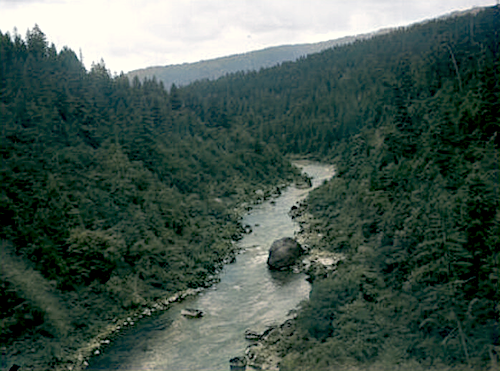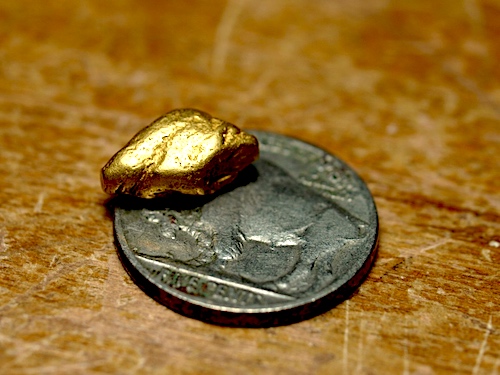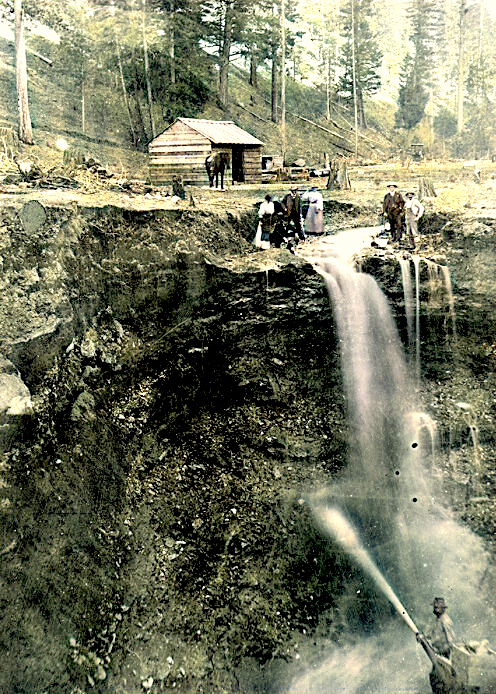Miners first arrived in Southwest Oregon during the mid-19th century. In the 1850s, reports of prospectors finding gold in the Rogue River and Umpqua River valleys was generating much interest. Soon men from around the world, including thousands of prospectors from the California goldfields, were venturing into the Oregon wild lands to search for the precious metal.
Rogue River Country
One major strike occurred on the mighty Rogue River, in the area now known as Gold Hill. Today, a major highway runs along the river, but back in 1851 this was isolated country.
Nonetheless, towns soon sprang up in the area. Jacksonville, Gold Hill, Waldo, and other small camps were strung all up and down the Rogue River Canyon.
There are several good access sites for prospectors today on the Rogue River. The “Gold Nugget Waysides” are small, roadside accesses where you can stop and try some panning.

The Rogue River has a long and rich history of gold mining. The section within the Hellgate Recreation Area is open to “hand and pans” prospecting. Even with this limitation, a hard working prospector can still find some very good gold here even today.
A long section with miles and miles of public access is within the Hellgate Recreation Corridor. Explore the area around Galice, but be sure you stay close the the river and don’t venture onto private mining claims!
There is gold all the way down at the mouth of the river too. In fact, early miners once panned the sands along the Pacific Coast at Gold Beach. These gold deposits were exceptionally rich, but also short-lived.
Applegate River
The Applegate River was bustling with activity as soon as gold was discovered in its rich gravels. Numerous mines were established in the region, including many rich tributaries.
Of particular interest would be the Sterling Mine, operated by the Applegate River Mining Company. The mine produced over $1 million dollars by the time it ceased operation. Today, there is access for casual prospectors to try and find gold at the Tunnel Ridge Recreation Site.
The area around Ashland had considerable activity during the 1860s and 1870s. This would become one of the most productive gold mining districts in Southwest Oregon.
The Umpqua River
To the north, prospectors were also finding rich gold deposits in the Umpqua River country. In the vicinity of Canyonville and Roseburg, men were finding paying quantities of gold in the river gravel.
As the placer deposits would eventually become depleted, focus would eventually go toward the hard rock deposits; the rich gold veins that fed the placers.

Southwest Oregon once produced multi-ounce gold nuggets with regularity. Now, most of the gold you can expect to find will be much smaller. This chunky piece weighs 5-grams and would be an excellent find nowadays.
Illinois River
The Illinois River drains into the Rogue at Grants Pass, but following the river toward California you will pass several old mining towns. The area around Kerby and Cave Junction are noteworthy.
Further to the south are Browntown, O’Brien, and Takilma. All of the tributaries in this area will produce some gold.
Althouse Creek is one very noteworthy creek. Starting high in the Siskiyou Mountains near the California border, this was one of the richest sites in all of Oregon. It also produced what may be the largest gold nuggets ever found in the state. Early reports indicate that at least two nuggets weighing over a dozen pounds were found in Althouse Creek!
Sixes River
Somewhat isolated from the other rich mining areas of Southern Oregon, some good gold has also been mined from the Sixes River, a coastal river that drains in the the Pacific Ocean in Curry County.
The best site for casual gold prospectors today is the Sixes River BLM Recreational Mining Site.
Coquille River
The South Fork of the Coquille River was most productive for miners, but this river wasn’t as rich as many other areas in Southern Oregon. As a result, it got a fair amount of attention from the early Chinese miners, who would generally mine areas that were ignored by the white miners.
Lower sections of the river were affected by tides and siltier which resulted in less mining. However, near the mouth river on the shores of the Pacific Ocean, very rich beach placers were worked for several years. The most productive section of beach was at Whiskey Run.
Hydraulic Mining
Hydraulic mining was common throughout Southwest Oregon. Miners would dig ditches and flumes to route water away from the creeks and into massive monitors. They would use the power of water to wash away bench gravels and release gold for extraction.
The scars left behind from these old hydraulic mines sites are still visible to this day.

Curious onlookers watch a hydraulic miners hard at work. High pressure hoses washed away exposed gravels, which would then be run through a sluice box to recover the gold.
Big Gold Nuggets of Southern Oregon
This region has produced some rather incredible gold nuggets over the years. Most of the biggest finds were made in the 1850s and 1860s, during the placer mining boom in the earliest days of the Gold Rush.
A few noteworthy discoveries include:
Improved Mining Technology
As the years went on, improvements in mining technology helped to open up new mines and reactivate some of the older abandoned sites. Cyanide leaching would play a major role in the overall gold production of the state in the later parts of the 19th century.
By the early 20th century there wasn’t much gold mining going on, not only in Oregon, but just about anywhere for that matter. Lagging gold price, and the depletion of the richest concentrations made it nearly impossible to turn a profit from mining.
The start of the Great Depression brought a short but vigorous renewal of mining activity in Oregon. For a few years, many of the old mines were reworked as men struggled to scrape out a living from the land. As the economy improved, they once again left the mines and ventured back to the towns and cities for better opportunities.
Mining in Oregon Today
The days of large-scale gold mining in Oregon is largely over. In addition to the depleted deposits and high cost of operation, regulations are now one of the major challenges. Operating a mining operation, particularly in waterways that have salmon, is incredibly challenging to get permitted for any large operations.
There are still some small-scale prospectors out there finding gold, but making a living from gold in Oregon is all but impossible these days.
Nonetheless, the early history of the Oregon Gold Rush can still be seen today. Many of the historic towns still dot the landscape of this region.
